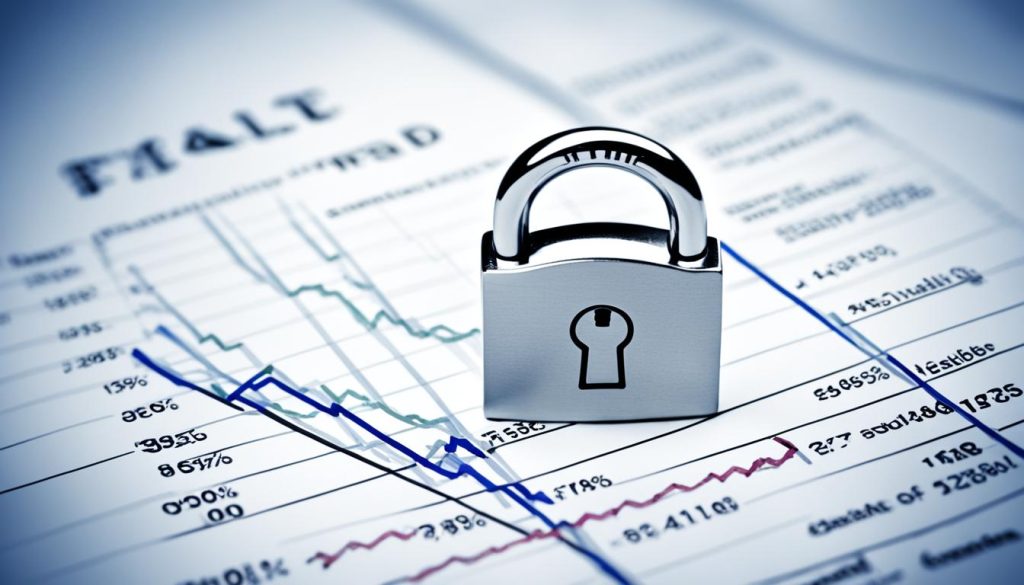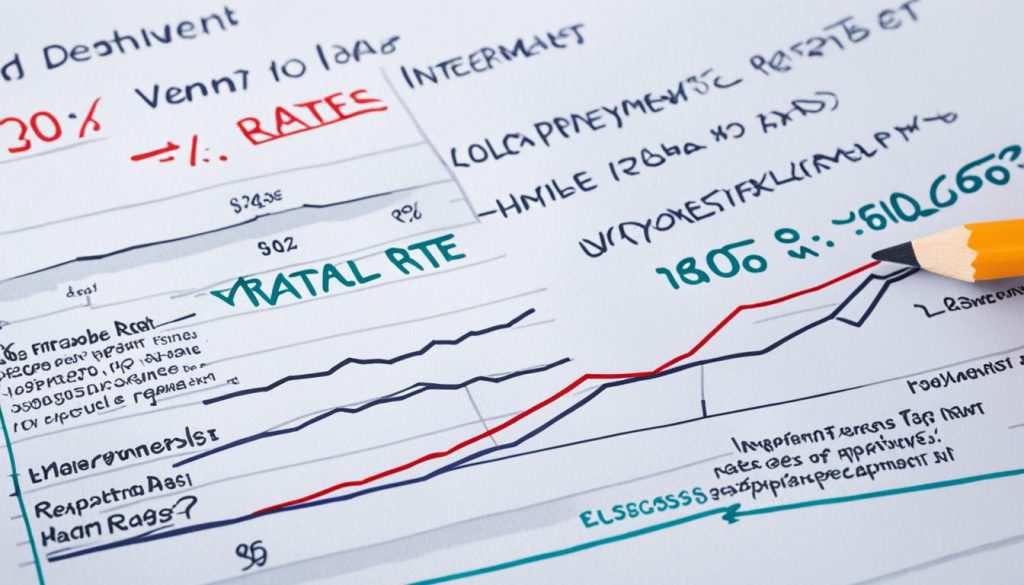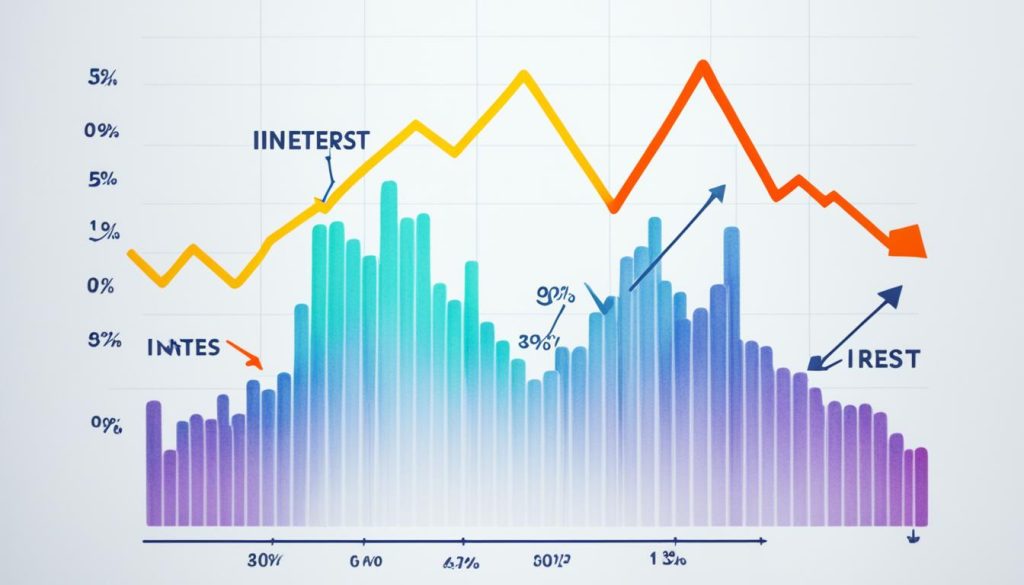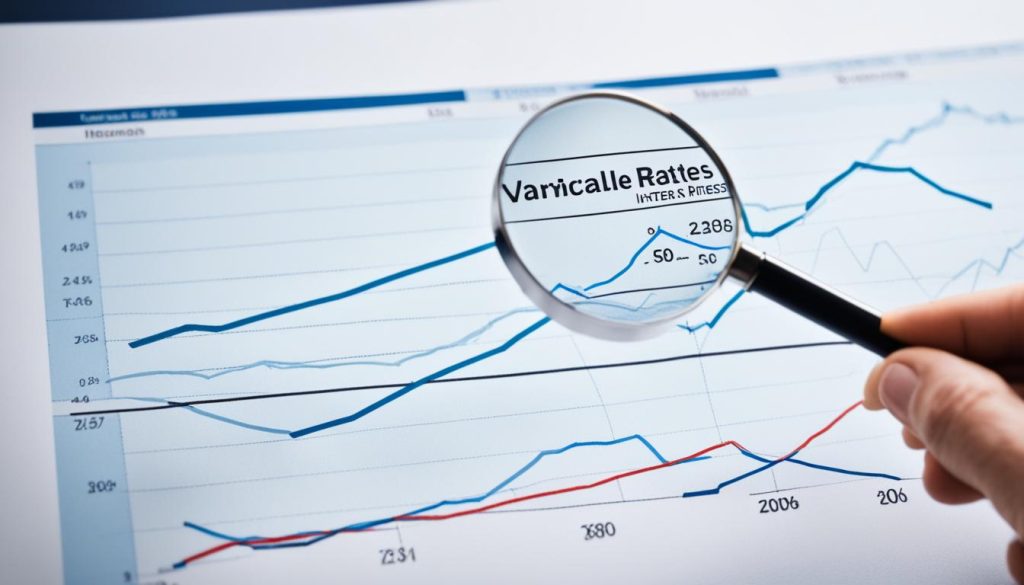When looking at loans, knowing the difference between fixed and variable interest rates is key. Fixed rates stay the same for the whole loan term. Variable rates change based on an index1. If interest rates go down, borrowers with variable rate loans might see lower payments1. But, if rates go up, payments could get higher, making these loans more expensive1.
Fixed-rate loans offer steady payments every month1. The choice between fixed or variable depends on your finances, how much risk you can handle, and what you think the market will do.
Key Takeaways
- Fixed interest rates keep the same rate for the whole loan, making payments predictable.
- Variable interest rates can change, possibly lowering payments when rates drop but raising them when they go up.
- Your choice between fixed and variable rates depends on your financial situation, income predictions, and financial goals.
- Fixed-rate loans give stability and protect you from rate changes. Variable-rate loans might lead to saving on interest over time.
- Think about your finances and market trends before picking between fixed and variable interest rates.
Understanding Fixed and Variable Interest Rates
What is a Fixed Interest Rate?
A fixed interest rate is a constant rate applied to loans like mortgages or personal loans2. It stays the same over the loan’s life, unaffected by market changes. This makes monthly payments predictable and stable2. At first, fixed rates are usually higher than variable rates but help borrowers know their costs upfront.
With fixed-rate loans, payments and total repayment stay the same throughout2. If interest rates drop, the fixed rate doesn’t change2. Lenders must warn borrowers before changing fixed rates under certain rules2.
Unlike variable rates, fixed rates are set at loan start and don’t change3. Examples of fixed-rate loans include mortgages and auto loans3.
“Fixed interest rates generally offer a predictable return and usually have higher Annual Percentage Yields (APYs) than variable-rate accounts.”4
Even though fixed rates start higher, they offer steady monthly payments and a clear borrowing cost over time2. This is great for long-term loans like mortgages or auto loans.
What is a Variable Interest Rate?
A variable interest rate changes over time. It depends on an index like the London Interbank Offered Rate (LIBOR) or the Prime Rate5. These loans have two parts: the index rate that changes, and a fixed margin set by the lender. When the index changes, so does the loan’s interest rate, affecting your monthly payment5.
Variable interest rates are found in many financial products, like mortgages, credit cards, and corporate bonds5. For credit cards, the rate can change without warning, tied to the Prime Rate5. Loans with variable rates work similarly but have set payment schedules5.
Adjustable-rate mortgages (ARMs) are a type of variable-interest-rate loan5. They start with a fixed rate before adjusting to market rates. ARMs use indexes like LIBOR as their base5. Some bonds also have variable rates, tied to LIBOR or U.S. Treasury bond yields5.
Variable rates can lead to lower costs when rates are low, but payments can increase if rates go up5. It’s important to consider the pros and cons of these rates, like lower initial costs but unpredictable future payments5.
Knowing the difference between fixed and variable interest rates is key to managing your finances3. Understanding variable rates helps you make better borrowing decisions and manage your money better3.
“Variable interest rates can change with the prime rate, seen in credit cards and HELOCs.”3
| Characteristic | Fixed Interest Rate | Variable Interest Rate |
|---|---|---|
| Rate Changes | Typically remain constant throughout the loan term | Can change periodically based on index rates |
| Rate Caps | N/A | May have caps limiting how much the rate can change |
| Frequency of Changes | Rare | Can change once or twice a year, depending on the loan |
| Predictability | Provides stability in payments | Fluctuates according to market conditions |
It’s crucial to understand the differences between fixed and variable interest rates for managing your finances3. Fixed rates offer stability, but variable rates can offer lower payments if rates drop. However, they can also lead to higher payments if rates increase3.
Variable interest rates are also found in savings accounts, tied to the federal funds rate or other benchmarks4. These accounts can offer higher returns if rates go up, but may have lower rates than fixed accounts4.
When looking at variable interest rates, consider the benefits and risks, and stay updated on interest rate trends4. Understanding variable rates helps you make better financial decisions and manage your borrowing and savings453.
Impact on Monthly Loan Payments
Fixed Interest Rate Loans
Having a fixed interest rate loan means your monthly payment stays the same from start to finish6. This makes budgeting easier because you know your payment won’t change, no matter what happens with interest rates6. The interest rate is set when you get the loan and doesn’t change, giving you stability6.
A fixed-rate mortgage can lead to the lowest monthly payments over many years because the loan is spread out over three decades7. On the other hand, a 15-year fixed-rate mortgage might mean higher payments but can save you money on interest and help you own your home faster7. Loans with terms of 20, 25, or 10 years offer a balance between lower payments and quicker equity building compared to a 30-year loan7.
Fixed-rate student loans usually have a higher interest rate but it doesn’t change, making your payments predictable8. This is great for people with low incomes who want stable payments that won’t go up8.

In summary, fixed interest rate loans give you a predictable monthly payment, which makes budgeting easier and keeps your finances stable6. This is especially useful during economic uncertainty or when interest rates are going up, as you won’t face higher payments678.
Impact on Monthly Loan Payments
Variable interest rate loans can change your monthly payments over time. This happens when the rate that the loan is based on changes8. If this rate goes up, so will your monthly payment, making budgeting harder. But, if the rate drops, you might save money8.
These loans can be both good and bad for borrowers8. They might start with lower payments, but could increase later8. This makes it hard to predict future payments, especially if your income or how long you’ll be paying changes8.
Thinking about how variable interest rates affect your payments is key8. While they might offer lower payments at first, the uncertainty can lead to financial issues later8. Knowing the details of these loans and keeping an eye on the market can help you make a smart choice. This choice should match your financial goals and how much risk you can handle.
https://www.youtube.com/watch?v=wkscvZNauJU
Interest Rates Explained, Fixed vs Variable Interest Rates
Understanding the difference between fixed and variable interest rates is key when dealing with loans and financing. These rates can greatly affect your monthly payments and the total cost of borrowing9. Let’s explore both types to help you choose wisely.
A fixed interest rate stays the same for the loan’s entire term. This means your payments won’t change, even if market rates do. In contrast, a variable interest rate changes with an index like the LIBOR or prime rate9. It’s the index rate plus a lender’s extra charge.
Variable rate loans usually start with lower rates than fixed ones9. But, these rates can go up or down, changing your payments10. For instance, if the prime rate goes from 3.58% to 1.82%, a loan at LIBOR + 5% would shift from 8.58% to 6.82%9.
Over the last 20 years, interest rates have swung between fixed and variable options9. The average 1-month LIBOR was 3.71% with a drop of -0.42. Meanwhile, the prime rate was 6.82% with a decrease of -0.399.
Choosing between fixed and variable rates depends on your financial goals and how much risk you can handle. If you want stability, go for a fixed rate. But, if you’re okay with some risk, a variable rate might save you money10.

Knowing how fixed and variable interest rates work is key to picking the right loan for you. By considering their pros and cons, you can make a choice that fits your financial future9.
Advantages of Fixed Interest Rates
Choosing between a fixed and a variable interest rate can greatly affect your finances. A fixed interest rate brings predictability11. Your monthly payments stay the same, making budgeting easier and more reliable.
In a low interest rate environment11, a fixed rate can save you a lot of money. You could save thousands over the loan’s life compared to a variable rate. This is great for homeowners, small business owners, and anyone wanting financial stability.
- Consistent and predictable monthly payments, making budgeting and financial planning easier12.
- Protection against rising interest rates, ensuring your loan payments remain the same throughout the loan term11.
- Potential to save money on interest charges compared to variable rates, especially in a low interest rate environment11.
With a fixed interest rate, you get the comfort of stable loan payments. This is key for long-term financial security and confident budgeting11121.
Disadvantages of Fixed Interest Rates
Missing Out on Lowering Rates
One downside of fixed interest rates is missing out on lower rates. If rates drop after you get your loan, you’re stuck with the higher rate. You can’t take advantage of the lower costs13. Getting a new fixed-rate loan might help, but it has extra fees13. Also, fixed-rate loans are usually pricier than variable-rate loans at first13.
Fixed interest rates make your monthly payments steady and predictable. But, they also stop you from using good market conditions to your advantage14. This is clear when interest rates are going down. You can’t get the lower rates and keep paying the higher rate14.
Choosing a fixed-rate loan might mean you miss out on big savings if interest rates fall a lot during your loan15. It’s a trade-off between knowing your payments and possibly saving more. This is something to think about when picking between fixed and variable interest rates15.
“The key disadvantage of a fixed-rate loan is that you miss out on potential savings if interest rates decline. Refinancing can help, but it comes with additional costs and fees.”
Advantages of Variable Interest Rates
Potential for Lower Costs
Variable interest rate loans can lead to lower monthly payments when interest rates go down16. If the LIBOR or COFI rate drops, so does your interest rate and monthly payment. This can mean big savings over the loan’s life16. These loans often start with lower rates than fixed-rate ones, which is good when rates are high and expected to drop16.
Even though fixed-rate mortgages are popular, variable rates have their perks17. They’re a good choice if you’re moving soon or plan to pay off the loan early. This way, you can save money with lower rates during the start16. They’re great for people with flexible finances or those expecting more money to cover payment changes17.

One big plus of variable interest rate loans is the chance to save money16. But, think about your finances, how much risk you can handle, and your future plans before picking between fixed or variable rates17.
Disadvantages of Variable Interest Rates
Variable interest rate loans might save you money, but they have big downsides too. The main issue is the risk of higher interest rates and payments that change every month. If rates like LIBOR or SOFR go up, so will your payments, making budgeting hard5.
This unpredictability can be a big worry for people with steady incomes or limited budgets5. Credit cards with variable rates can change without telling you5. Loans with these rates can also change based on the interest rates and how much you owe5.
Adjustable-rate mortgages (ARMs) start low but can go up later, leading to higher payments if rates rise5. ARMs have limits on how much rates can change, but big increases are still possible, causing financial stress5.
Investors in bonds and derivatives like interest rate swaps face the risk of higher rates too5. This can hurt their returns and make it hard to predict their cash flow5.
In short, variable interest rates can lead to big payment increases, making it hard to budget. They also make it tough for lenders to predict their cash flow5. Borrowers need to think carefully about these risks and benefits before choosing a loan.
“Variable interest rates can be a double-edged sword, offering potential cost savings but also exposing borrowers to the uncertainty of rising rates and unpredictable payments.”
Choosing Between Fixed vs Variable
Choosing between a fixed or variable interest rate loan depends on your financial situation, how much risk you can handle, and what you think the future interest rates will be1. You should think about your cash flow, whether you want stable payments, and what you expect interest rates to do in the future. If you like knowing what to expect and want stability, a fixed-rate loan might be for you. But, if you’re okay with some uncertainty for a chance to save money, a variable-rate loan could be better1.
Fixed-rate loans mean your monthly payments stay the same, no matter what happens with interest rates1. On the other hand, variable rates change with an index that can go up or down1. A common type of variable rate loan is a 5/1 adjustable-rate mortgage (ARM), which has a fixed rate for five years before it can change1. You can find variable interest rates on mortgages, credit cards, personal loans, derivatives, and corporate bonds1.
Research shows that over time, people usually pay less interest with a variable rate loan than with a fixed-rate one1. But, ARMs can be good when interest rates are going down, but payments can go up when rates rise1. You can also mix your loan into both fixed and variable rates with split rate loans1.
When deciding between fixed and variable rates, think about the direction of interest rates, how long you plan to keep the loan, your income outlook, and your financial situation1. Lenders might let you switch from a variable to a fixed rate, but there might be fees for it1.
In the end, picking between fixed and variable interest rates is about balancing knowing what you’ll pay and the chance to save money. By looking at your finances and how much risk you can handle, you can make a choice that fits your goals1.
Historical Interest Rate Trends
Interest rates have changed a lot over the decades, showing how the financial market changes. In the 1970s, the 30-year fixed-rate mortgage was about 7.3% at the start and hit 12.9% by 197918. The 1980s saw the U.S. home cost jump from $63,700 to $123,900, with the 30-year rate peaking at 18.4% in 198118.
The 1990s brought a drop in the 30-year mortgage rate to 6.91% in 1998, thanks to the dot-com bubble.
By 2009, the 30-year fixed mortgage rate fell to 5.4% from about 8% at the start of the 2000s, due to the subprime crisis18. The 2010s began with the 30-year rate in the 4% range and went below 4% by the end18. In 2020, it hit just under 3%, averaging 3.38% due to the pandemic.
Looking ahead18, by April 2024, the average 30-year fixed mortgage rate was at 7.05%, over 8% in October 202318. Historical data shows the 30-year fixed-rate average as follows:
- 2023: 7.00%
- 2022: 5.53%
- 2021: 3.15%
- 2020: 3.38%
These trends affect how much it costs to borrow and the housing market19. A 1% change in rate on a $15,000 loan for 48 months means a $328 difference in interest19. A $200,000 loan with a 2% rate change over 15 years means over $36,000 more in total payments.
Understanding these trends helps borrowers choose between fixed and variable rate loans20. Lower mortgage rates make buying a home cheaper, allowing for bigger purchases20. When rates are low, refinancing can save homeowners money each month, helping with debt or savings.
| Year | 30-Year Fixed Mortgage Rate |
|---|---|
| 2023 | 7.00% |
| 2022 | 5.53% |
| 2021 | 3.15% |
| 2020 | 3.38% |
By watching interest rate trends, borrowers can make smart choices for their finances20. Data shows 30-year fixed rates are usually higher than 15-year rates. Five-year ARMs often start with lower rates than 30-year mortgages, becoming more competitive as 30-year rates rise.
Conclusion
Understanding the difference between fixed and variable interest rates is key when choosing a loan. Fixed-rate loans offer stable monthly payments, protecting you from market changes21. Variable-rate loans can be cheaper when rates go down but may cost more if they go up22.
Your financial situation, how much risk you can handle, and what you expect from the market will guide your choice23. Think about the pros and cons of each option to pick the best one for your goals. This could be about fixed vs variable interest rates, loan decision, financial planning, or handling interest rate risk.
Your mortgage is a big financial step, so look at all your options and get advice from experts. With good planning and understanding the market, you can choose wisely. This way, you’ll be set for financial success.
FAQ
What is the difference between a fixed and variable interest rate?
A fixed interest rate stays the same for the loan’s entire term. It doesn’t change with market conditions. On the other hand, a variable interest rate changes over time. It’s based on an index like LIBOR or the Prime Rate.
What are the advantages of a fixed interest rate loan?
Fixed interest rates make budgeting easier because the monthly payment stays the same. They’re great for those who like stability and want to avoid rising payments.
What are the disadvantages of a fixed interest rate loan?
Fixed rates might mean missing out on lower interest rates later. If rates drop, you’re stuck with the higher rate. Refinancing can help, but it comes with extra costs.
What are the advantages of a variable interest rate loan?
Variable rates can lead to lower payments when rates go down. This can save you money over the loan’s life.
What are the disadvantages of a variable interest rate loan?
Variable rates can increase, making payments unpredictable. This can make budgeting harder and increase expenses.
How do I choose between a fixed or variable interest rate loan?
Choosing depends on your financial situation, how much risk you can handle, and your predictions about interest rates. Think about your cash flow, need for stable payments, and future rate expectations.
What are the historical trends for interest rates?
Over the last 20 years, interest rates like LIBOR and the Prime Rate have mostly gone down. This shows that while rates can change a lot in the short term, they tend to be lower over time.
Source Links
- Fixed and Variable Rate Loans: Which Is Better?
- What is a fixed interest rate?
- Fixed vs. Variable Interest Rates | Capital One
- Fixed vs. variable interest rate: Which is better for your savings now?
- Variable Interest Rate: Definition, Pros & Cons, Vs. Fixed
- How rising interest rates affect you and what you can do about it
- Fixed vs. Variable Mortgage Rates: Making the Right Choice | CUSO Home Lending
- Fixed Vs. Variable Student Loan Rates | Bankrate
- Business Loan Interest Rates: Fixed vs. Variable Rate
- Should I Choose a Fixed-Rate or Variable-Rate Mortgage?
- The Pros and Cons of Fixed Interest Rates Explained
- The pros and cons of fixed vs variable interest rates
- Fixed vs. Variable Mortgage Rates | Comparing Pros and Cons | Ratehub.ca
- Fixed vs. Adjustable-Rate Mortgages: What’s the Difference? | Bankrate
- What Is A Variable Interest Rate?
- Fixed APR vs. Variable APR – Experian
- Mortgage Rate History: 1970s to 2024 | Bankrate
- Articles
- Historical Mortgage Rates: Averages and Trends from the 1970s to 2022
- A simple guide to fixed vs variable home loans
- Fixed vs. Adjustable-Rate Mortgage: What’s the Difference?
- Variable vs. Fixed Mortgage Rates. What’s the Difference?

